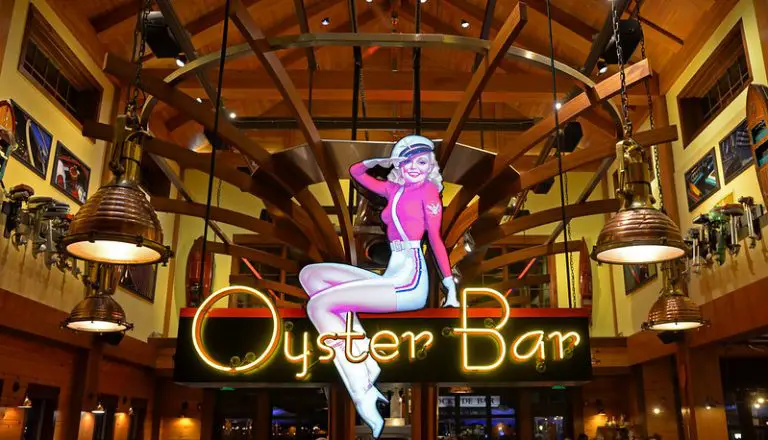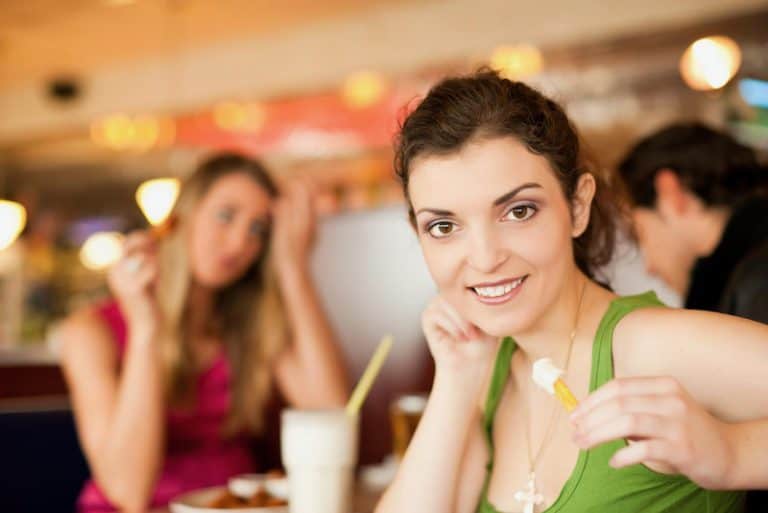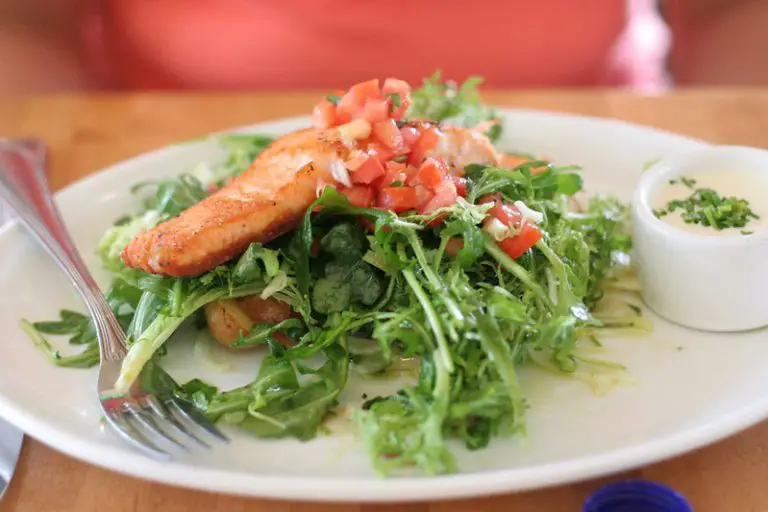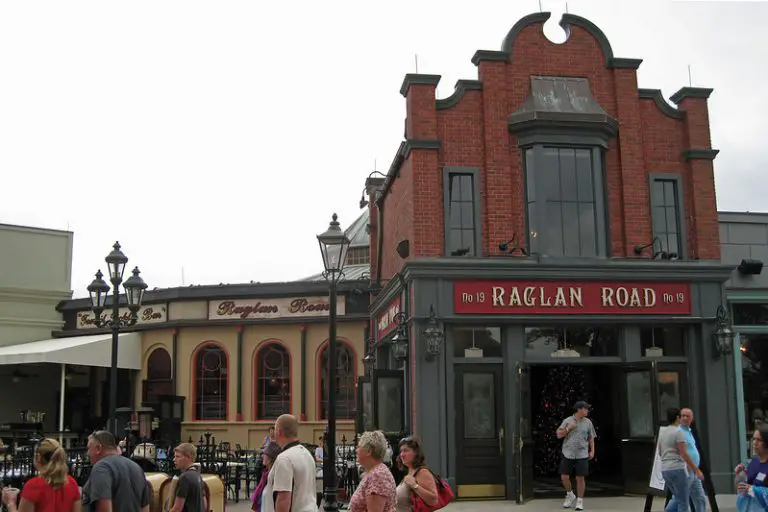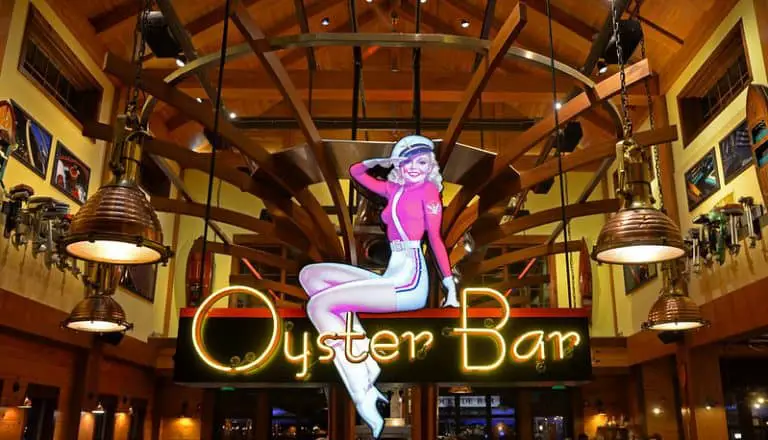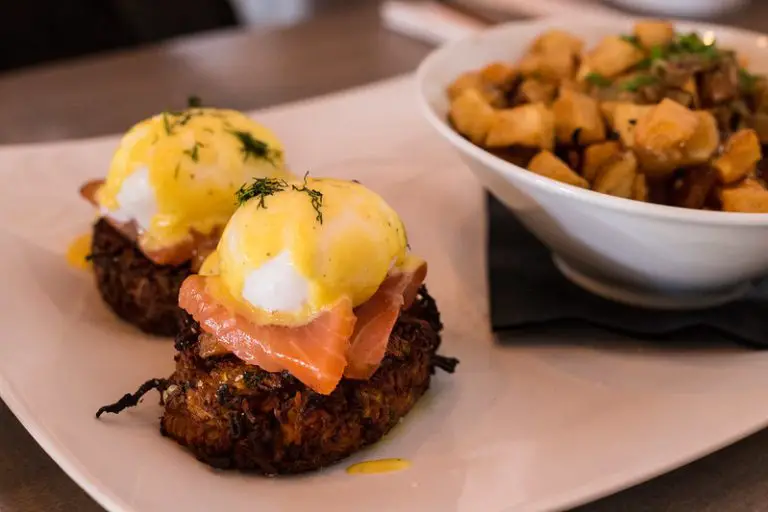Morimoto Asia review
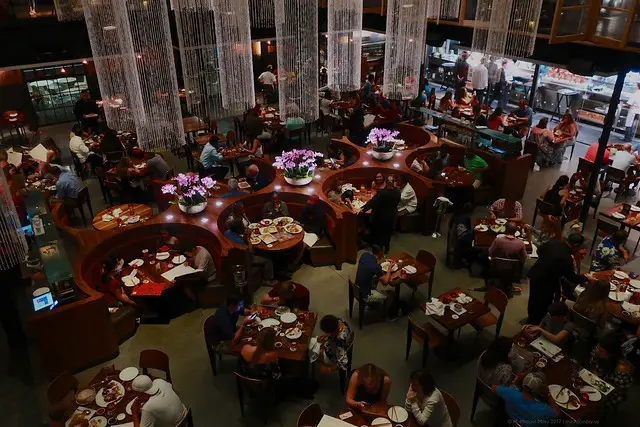
Imagine walking up to an old bottling building after crossing a bridge from a bright pink cupcake ATM. Hard to imagine, right? But that’s exactly what you’ll see when you walk up to Morimoto Asia in Disney Springs (previously Downtown Disney) at Walt Disney World Resort. It’s a three-story building almost entirely encased in glass.
From the outside, there are signs that read “Morimoto Asia” in red vertical letters (similar to a Japanese style of writing rather than an American style). The entrance has three wide stairs, a stylishly framed menu and the ten-foot glass doors are almost always open.
There is a street food patio on the left side of the doors and a “Forbidden Lounge” only open for late night dining. Upon walking through the main doorway, hosts wearing red kimono dresses, black shoes, high buns and red lipstick (I’m fairly certain the lipstick isn’t a requirement but more a stylistic choice.) greet you.
Atmosphere
There’s a long host stand directly in front of an additional lounge area. If you don’t have a reservation, you can seat yourself (provided there is room) in the lounge area or sit at one of the two bars. These bars are far from ordinary.
Aside from the many colors, floor to ceiling glass art and an impressive sake display, the bar itself is a flowing work of art. It starts as a long white surface but extends past the bar and lounge area, twisting and turning past the stairs and up into the second floor, where it becomes the surface of the second-floor bar.
It’s more of a modern sculpture than a surface on which to set one’s drink. The bar stools are comfortable and offer cushioned backs (which is wildly appreciated after a day of park-hopping). If you can’t get a reservation, this is always a nice alternative.
If you are able to get a coveted reservation, the hostess will show you to your seats either on the first or second floor. The first floor is the largest room and has an open kitchen, where the chefs can be seen hard at work. Hanging between the chefs and the dining room are rows of Peking ducks.
If you’ve never seen one before, it can be a little off-putting to see a whole duck (sans feathers) hanging there but it is mouthwatering and authentically Asian to have them hanging about the restaurant.
Towards the middle of the dining room (that is a mixture of booths and tables) is the grand staircase. It’s a huge glass staircase. The stairs and railings are glass and it allows for lovely natural light throughout the space. Immediately upon arriving upstairs, there is a long, glass sushi bar. Sushi chefs prepare orders of ultra-fresh and intricate sushi/sashimi “towers” seemingly nonstop.
If you’re seated at the sushi bar and are particularly nice and tip well, they might even make you their personal favorite combinations! Fresh fish fillets are on display and are shown to each Guest sitting at the sushi bar before they are sliced with dangerously sharp knives and placed artfully on round black plates.
To the left of the sushi bar is a private party area with bamboo screens offering some privacy in an otherwise wide-open restaurant. I have never had the pleasure of dining in the private rooms but walking through, the ambiance is lovely and more intimate. To the right of the sushi bar, there is a second bar made from the twisting, bone white sculpture.
They do offer select menu options at the bar but not everything so if you’re hungry, I suggest getting a table or eating at the sushi bar (where they do offer the full menu). If you are able to take in the beautiful features and mouthwatering food on the first and second floors, looking up even further is a treat as well.
Multiple tiered glass chandeliers hang from a dark, industrial ceiling. The duct work is on display and it makes for a stark but elegant juxtaposition against the sparkling chandeliers. The atmosphere of the restaurant is oddly industrial while also being elegant and it makes for some unique pictures for your social media feeds.
Coming back down from the ceiling and to the ground, the servers are always attentive – no matter how busy the restaurant might be. They pride themselves on making each Guest feel welcome and not at all rushed. A lot of menu items are new to many Guests, so the servers ask questions, make recommendations and offer explanations on the more unfamiliar options. This brings us to the very best part, the food.
The Food
Morimoto Asia, while a definite Japanese influence is apparent in the décor, is a multicultural Asian restaurant. Chef Masaharu Morimoto (a celebrated celebrity chef, perhaps best known for being an Iron Chef on the Food Network) was tasked with creating a restaurant for Walt Disney World and he wanted to showcase his favorite parts of the cuisine from each culture.
Peking Duck from China pairs beautifully with strong Japanese sake and every combination has a personal touch from Chef Morimoto. He has made each and every dish for his own family and he judges it based on their opinions. These dishes are recipes his own family has eaten and given the stamp of approval.
How do I know this, you might ask? It’s information you can’t go a meal without finding out. Simply ask any of the servers (if they don’t offer the story before you can ask) and they will delve into a passionate retelling about how Chef Morimoto took his dream and made it a reality. I have asked six different servers and they all have the same story.
Each dish has a reason for being on the menu other than it simply tasting delicious, although that’s more than enough reason for me. For example, Chef Morimoto was inspired by the Korean bibimbap and won one of his Iron Chef battles with his rendition he calls Buri-bop.
Traditionally, bibimbap is a rice dish made in an extremely hot cast iron bowl. At Morimoto Asia, they wheel out a giant, white-hot clay pot and prepare it tableside. It’s a display of talent while also being a good chance to learn about why this is so important to the preparation and how they modernized it at the restaurant.
Buri refers to Hamachi or Yellowtail fish so Morimoto decided that would be the perfect way to merge a Korean dish with a classically Japanese ingredient. The servers prepare a generous helping and the smells are intoxicating. Ginger, onions, rice, fish and an egg yolk all come together to form the modern Buri-bop.
If you want to learn more about the dish, as well as how to make a version of it yourself, he did an interview with Food and Wine magazine that can be found here. I’ve made it at home but it never turns out quite as good as what’s served in the restaurant. Most people choose to share it along with other entrees or small plates but I could easily eat the entire dish myself.
Unfortunately, I feel that way about most of the foods here. As I mentioned earlier, the sushi is incredible. The chefs use fresh crab meat in their California roll (none of that packaged imitation stuff here!) with the perfect rice to crab ratio.
Aside from the extensive sushi menu, which includes impressive towers of sushi, they also have a menu of “small plates” and dim sum. These include items like fluffy pork bao (pork buns), crispy Rangoon, all manner of dumplings, egg rolls, tempura, poke and so much more. The bao is the perfect combination of sweet, tender pork belly, crisp lettuce and spicy aioli. I could eat ten of these and you will probably want to, too.
My top five recommendations are:
- Morimoto Spare Ribs
- Buri-bop
- Peking Duck
- Kakuni Pork Bao
- California roll – they serve an upgraded version of the classic sushi roll.
Aside from the authentic dishes, they also offer more familiar options like chicken fried rice or macaroni and cheese for picky eaters. These are excellent and allow for families with children to enjoy the experience equally. The dessert menu is varied offering choices like yuzu pie and mochi along with options more “vanilla” eaters might enjoy like tempura fried Oreos and churro fondue.
The Drinks
The drink menu is long but undoubtedly filled with something for everyone. I suggest Thai Tea. While it’s not an endless refill (so if you want more, you’ll be paying for it twice!), it’s delicious, sweet and refreshing. Along with the normal choices of Coca-Cola products, they also provide a refreshing selection of wines, draft beers, cocktails and sake.
A popular choice is the Sake Sangria which can be ordered by the glass or by the pitcher (about four servings total) if everyone wants to try an Asian spin on a European classic. They are generous with the amounts of alcohol and everything is hand prepared. From the hand-squeezed lemonade to the yuzu syrups, each menu item requires time and labor. Unfortunately, that quality and amount of labor comes with a price.
Pricing
If you’re familiar with Disney Dining menus pricing, lunch is characterized with two $$, which means an adult meal is typically between $15.00 – $35.00, including a non-alcoholic beverage. Dinner and lounge prices are given three $$$, which means an adult meal is between $35.00 – $60.00. This doesn’t include any alcoholic beverages, so it’s easy to spend over the $60.00 since alcoholic drinks normally run between $10.00 – $15.00/glass.
Fortunately, they do accept Disney Dining plans. This is a great article detailing the ins and outs of the Dining plan system if you want more information.
On average, the appetizers are $11. The entrée prices vary widely but I would budget about $30.00 for an entrée. The Peking Duck is a great deal at only $29.00 serving two people. It comes beautifully presented with “pancakes” you’re meant to put some duck, crispy duck skin and rice inside to make a satisfying bite.
It’s delicious but I suggest upgrading the plain rice it comes with to vegetable fried rice, which will cost about $7 more. Another favorite is the Morimoto Spare Ribs. I’m not sure how they managed to perfect the spare rib, but they’ve done it and I’m amazed they only sell out some nights. They are pork ribs, that are sticky, sweet, crunchy (I know, I was bewildered too!) and literally fall off the bone.
I like to twist the bone and slide it out before digging into the succulent meat. It’s that easy. The price is hefty (but worth it) at $27.00. I would suggest getting this and a few other dishes to share. As a disclaimer, this is one of the options that does not come with a side dish and isn’t a dish that includes all meal components (i.e. fried rice, lo mein, ramen, etc.).
It only comes with the ribs so it’s probably not a good choice as a stand-alone meal. If you’re looking to round it out, I would suggest ordering a side of rice or stir-fried seasonal vegetables.
Alternately, you could try the aforementioned Buri-bop. This is delicious but compared to most Disney meals where a large price tag often implies a large portion, Buri-bop does not follow that formula. It’s $32.00 for the entrée but it’s worth every dollar.
If you’re feeling extravagant or celebrating a special occasion, they also offer Japanese A5 Wagyu Beef. A5 is certified as the highest quality of all Wagyu beef so it’s the best of the best. It’s prepared tableside on an ishiyaki (essentially, porcelain) grilling stone and costs $24.00/ounce with a three-ounce minimum.
It’s easily one of, if not the most, expensive items on the menu but the experience is unlike any other. I explain it like an experience because everything from the smell to the final bite teeters on the edge of an out of body moment. It’s savory and tender and almost melts in your mouth. You can literally push your tongue against it and it will fall apart.
If you’re a beef lover, this is one experience worth saving for. Since most Disney World Vacations are something people save up for anyway, it makes sense to experience it here!
Reservations
With delicious food, stunning décor and attentive servers, this is a popular place to eat. Same-day dinner reservations are nearly impossible to get, especially on weekends but they do take walk-ins. Those walk-ins always come second to Guests with reservations and often wait over an hour to even be seated.
Lunch tables are a little easier to come by but only on the week days. Weekends almost always necessitate a reservation. If you didn’t plan ahead, skip breakfast and get to the restaurant right at opening, 11:30 a.m. They don’t typically have a wait until noon and lunch is a little more affordable, which is a nice bonus.
However, if you are a planner, I would suggest saving this restaurant for a special night and getting a reservation a few weeks in advance. Dining reservations can be made 180 days in advance so take advantage of that! If all else fails, the quick service window is a good option but stay away from the sushi and gravitate toward the bao and mini-ribs.
The sushi is premade, so it sits in the (refrigerated) window all day but the bao go straight from the steamer onto your plate and the ribs are almost as good as the ones inside if they’re eaten first. Overall, this is one restaurant that is definitely worth stopping at. The sheer amount of options can be daunting, but Morimoto Asia is easily one of the best Walt Disney World restaurants and should always be at the top of your dining plans.
If you enjoyed this article, please “like” our Countdown to Magic Facebook page!
You Also Might Want to Read:
- The 12 Most Popular FastPasses at Magic Kingdom
- The 10 Most Popular FastPasses at Epcot You’ll Love
- The 10 Most Popular FastPasses at Animal Kingdom
- The 7 Best Disney World Souvenirs You’ll Want to Buy
- The Top 10 Disney Resorts Ranked from Best to Worst
- The 7 Best Disney Attractions for 5 Year Olds That Are Super Fun
- The 8 Best Disney World Tips for Toddlers That Parents Will Love
- The 7 Best Disney Hotels for Large Families You’ll Love
